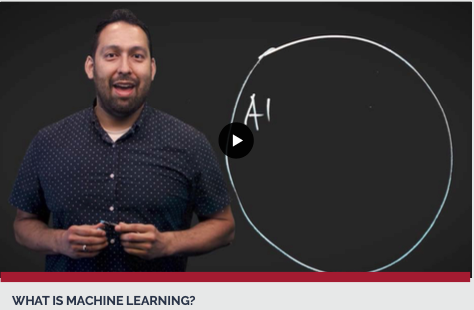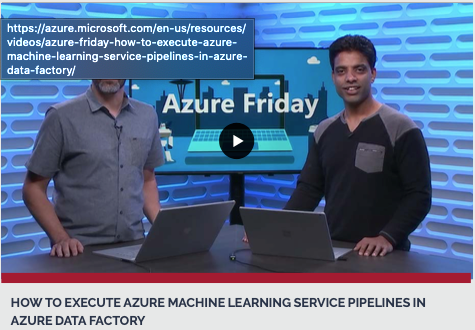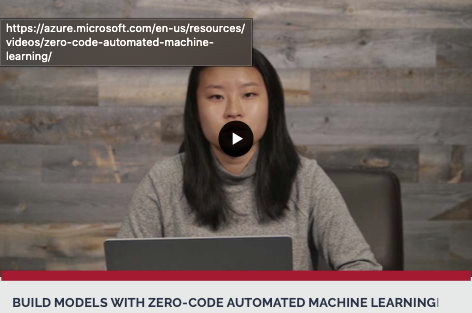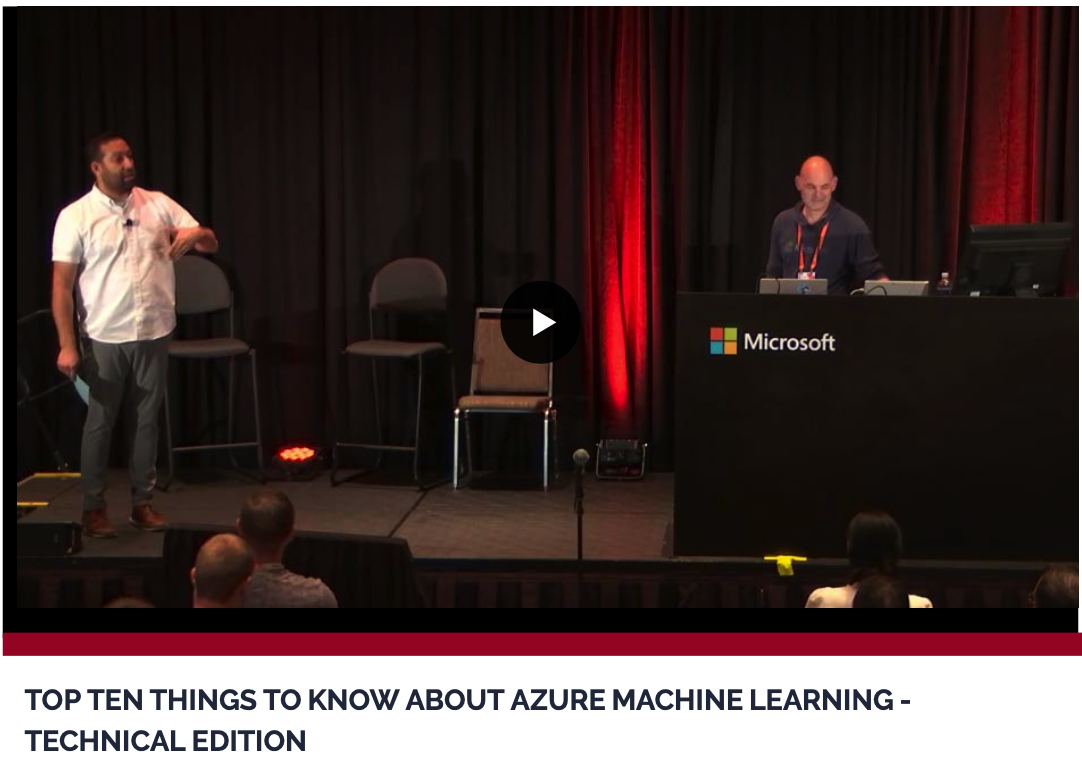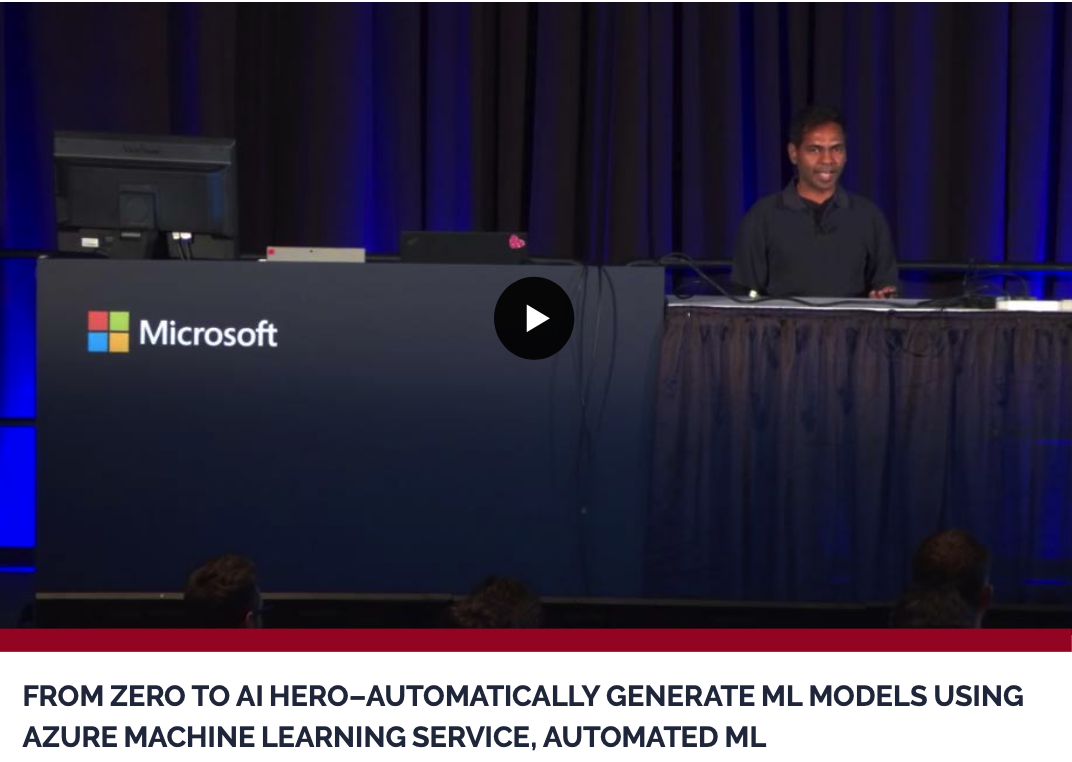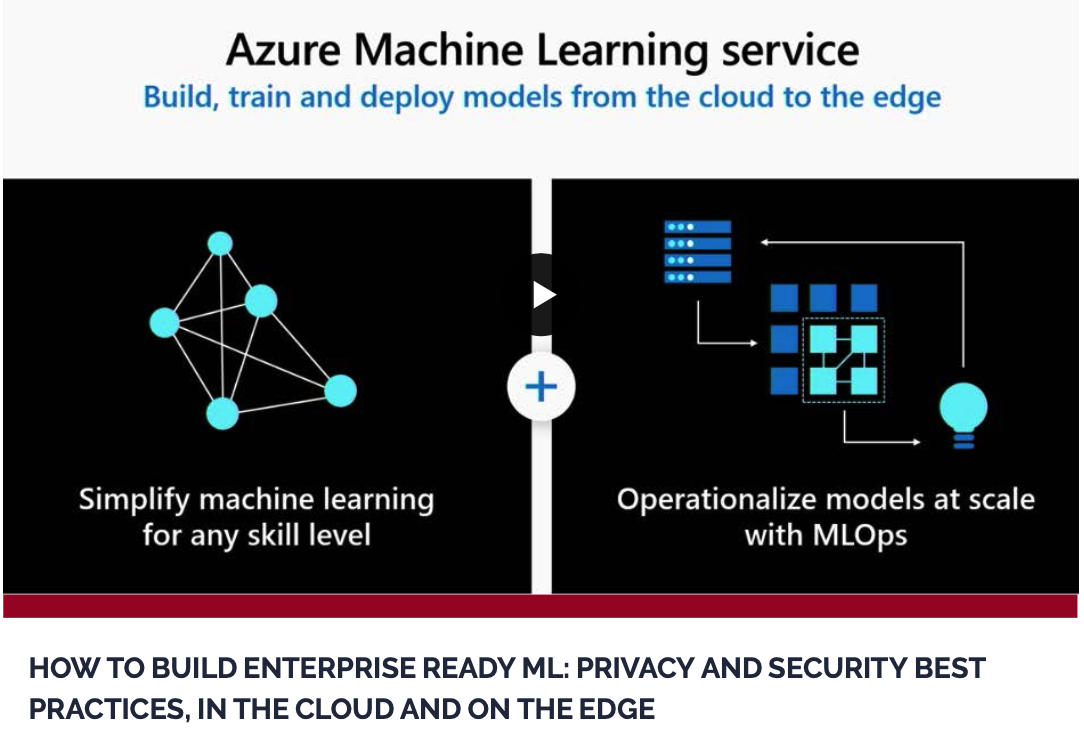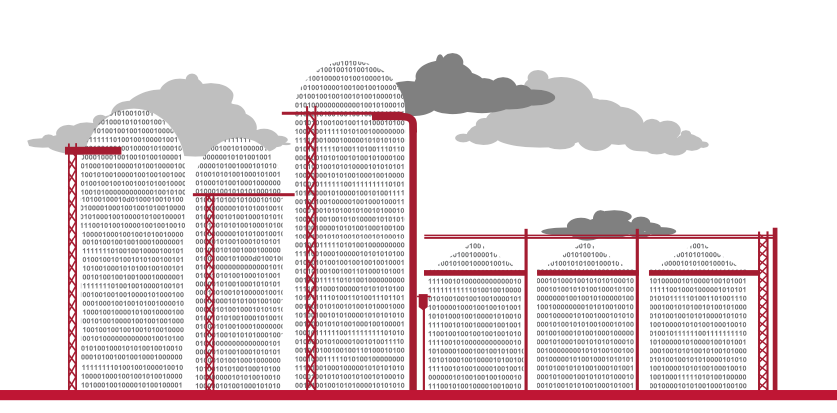
Marketing White Paper
University Point Systems or Enterprise Solutions
Continue Fragmentation or Start Aggregation?
Executive Summary
Which, if any, is the best application management software for a university? There are two basic choices: adopting a point solution system or an enterprise solution. The primary consideration for choosing any new software should not be how well the software works in today’s context; instead, consider how the software will work both today and over the the next seven to 10 years of use.
Point solutions, by nature of their implementation, fragment student data into departmental silos. Data captured through siloed practices does not effectively integrate into university- wide strategies, including ongoing digital relationships, brand building, and lifelong learning initiatives. This resulting sequestration of data represents an opportunity cost, as future university digital interactions won’t be able to capitalize on this data.
Student records should become secure brand interactions. Data stewardship is a critical consideration. Using data in a university-wide context, instead of a departmental context, creates opportunities to assure data security and better student experiences. It also enables departmental assets to be leveraged university wide.
In this context, focused department-specific software is not ideal since it has many barriers to achieving the objectives that will be required in the next five to 10 years. Some departments may be against seamless integration because of inappropriate internal priorities, such as not wanting to work through the existing inertia of silos to perform their departmental work.
Slate promotes themselves as designed and developed exclusively for higher education. It is designed to streamline the process of scheduling visits with college reps. Slate targets small schools with little experience in basic CRM capabilities and includes features that are useful in the recruitment process, such as portfolios, event management, email management, and personalized stakeholder portals. The timeline for integration is expected at 12 months.
However, Slate is firmly niched as an admissions company, not a software company. Ongoing support has been reported as poor. Once you move past the basics, users report that implementation was more complicated and required more programming than advertised.
Avoiding a point solution opens opportunities for the university. New, best-in-class software solutions like Microsoft Power BI, Red Hat, or Oracle, which use artificial intelligence (AI) and standardized machine learning code, will not integrate efficiently for dynamic uses with siloed point solutions. New solutions are necessary for new solutions, such as the ability to target at-risk students with support.
A single, unified university platform allows for innovation with custom applications (student experiences) that are future-compatible and efficient at capturing diverse student data points. Point solutions are not best-suited for a growing university in a competing market in need of a top-level technology stack platform or enterprise application.
It is recommended that universities adopt enterprise-level systems that can take advantage of new technology stacks, like Microsoft, IBM, or Oracle. This will allow a university to keep up with changing market demands. Security is unmatched in these institutional strength platforms when compared to independent players.
Universities can greatly benefit by upgrading existing enterprise systems to achieve new cost efficiencies. The student experience and two way communications should be at the center of all software purchase thinking when configuring new technologies. Each part of the upgraded enterprise system should be allowed freedom to be configured around departmental needs by discipline-specific professionals.
Conclusion:
Selecting a point software, positioned as a total admissions solution versus an integrated “modern stack” solution, will solve some challenges while creating more obstacles to efficient progress in the following years.

Software Solution Crossroads: Which Path to Take?
The purpose of this white paper is not to bring into question if Slate is the best application management solution for universities. Rather, it’s to raise the question: In 2020, is any application management software the best “solution” for a university?
There are only six truly end-to-end enterprise ecosystems for higher education. They include:
- Anthology (previously Campus Management)
- Oracle Student Cloud
- Workday
- Ellucian Banner / Colleague
- Jenzabar
- mysis
Surrounding the end-to-end enterprise ecosystems are numerous CRMs, applicant tracking systems, student experiences, learning management systems, ERPs, and thousands of cloud point solutions that add features. In education, the clouding buzzwords make it easy for point solutions to be repositioned as SIS systems or a cheaper way to achieve the same functionality.
To Point or Not to Point?
The general challenge with individual point solutions: they silo and rob your data possibilities. This makes it cost prohibitive to leverage independent pieces of data, mashup byproducts, and derivatives thereof, for anything other than the single previously programmed purpose.
This downside has been clouded in the buying and selection process and addressed in the selling process. Creators provide “APIs” and import routines to move the point solution information into and through other systems to use the data. In practice, based on cultural, operational, and technology restraining forces, this stunts the ability for universities to safely and efficiently leverage their students’ data and the correlating effects for the enterprise.
This data could be used to reveal millions of cost-effective opportunities to connect with individual constituencies through the power of structured and unstructured data (e.g., AI and machine learning capabilities that will drive the next 10 years of progress in all types of customer interactions). The actual deployment stunts an organization’s ability to leverage its content for organic relevance, segmentations, and engagement.
At this time, personalized relationships are the driver for student success. It’s time to start building on these relationships and leverage them into the power of digital transformation. This isn’t the sole relationship between a student and an admissions advisor, where the student functionally disappears after the university receives the check. Instead, many departments represent the brand as the student enjoys benefits from the relationship with the university. In this way, the relationship with the entire brand stewards the entire student journey through lifelong learning.

Long-term Solutions for Success
When the right systems are chosen, necessary shared services that support student success can cost less than needed patch work and point solutions. When all talents within a university go to work with the student interaction information, new and amazing possibilities will emerge to compete and differentiate the brand within the market.

Choosing the Right Ecosystem—Questions to Ask
Considering the trajectory of a university and its markets over the last decade, plus careful analysis of current data trends toward digitally-centric brand interactions, reveal the facets to find the best fitting and most efficient path forward over the next decade.
Interestingly, when balancing future and past uses, the solution sets are clearly and significantly different than what might be considered the best approach for satisfying one department’s needs and most probable user conditions.
Would the purchase and investment into the migrations and configurations needed to customize a point solution software for use as an “application management solution” propel a university to where it needs to go?
- Consider the migration of current functionality and connections of all other used software and processes the data could be connected.
- Does it do so with the least amount of overall inertia?
- Does it leverage forward the lessons learned over the previous five to seven years in this area, and the most likely probabilities of the next ten years?
Will each step of progress—each new application, process, training, database created, template filled—help the university along the way to safely and incrementally build the most efficient digital student interactions of the future?
- Or does it do the opposite? By providing only a few pieces of the overall puzzle for one part of the institution under the glitter of new, self- controlled, spot functionality?
Are the criteria of selection better than what exists?
- Consider the PTSD experienced with past failed implementations of fragmented point solutions or years of outdated or partial deployments of the enterprise management installations.
- Is the assessment based on catching up to what is better and more acceptable than what currently exists?
- What if what exists now with the software functionality is already 10-15 years behind what is most efficient?
- What if updating based on these two contributing standards begins another five-year journey to utilization that ends with replacing the “new” program and all the learnings, templates, databases, etc., and doesn’t perform the “new things” required?
Should the criteria become “the best possible that could be achieved with the budgets and energy for the overall organization?”
- Should this thinking include all departments interacting with the students and students’ overall experience with the brand—before, during, and after tuition is paid?
- This can be accomplished with the same, or even fewer, overall dollars and time invested.
Should the focus be selecting software and methods within the university that leverage each department’s capability and interaction with the students into a common record?
- The right solution can be securely shared with university stakeholders in requisite real time to create amazing student experiences with absolute security and compliance.
- Should this new capability create a new relational data asset at no additional costs, in stride, as each person performs their everyday job?
- Will this investment be fulfilling the university’s future mission in the digital economy in new ways yet to be seen?
- If the digital records are not aggregated and built from the interactions with each student, will the assets and bridge to lifelong learning empowerment in a digitally driven economy be diminished?
- Based on security and use access?
- Based on departmental silos?
Should universities shift more thinking to developing infrastructure to enable the new digital economy?
- And if so, in what areas of data collection, data use, and digital interfacing will universities have to adapt over the next decade?
- Consider this: student records encompass much more today than they did five years ago, and even last year. New foundational changes (AKA the backbone infrastructure or tech stack) and method changes have combined to allow an exponential leap in capability, security, and efficiency.
- Student records need to become secure brand interactions that are not owned by a single department. Instead, specific data meant for the use of that department ought to be leveraged and secured on behalf of the student, not just the department.

New, dynamically secured and purposed digital records can be deployed at the enterprise-level of confidence. When data is secured at the university level, rather than on point solutions controlled by department or a “separate admissions CRM “ database with single department access, new possibilities arise.
Barriers can be shattered with the new ability to parse secure brand interactions on behalf of the student and on behalf of the entire institution, in contrast to the key result areas of a solo department. A single attribute at the core of enterprise-level software efficiently removes data fragmentation and siloed structures, enabling all departments to contribute to shaping students’ digital experience and ultimate success.
Imagine empowering the university’s best and brightest students with a single student record, drawing from all the other student transaction systems, including the CRM, SIS, LMS, and even a student’s activity outside of campus, such as student groups and clubs, event attendance, and functions.
With new methods, each department doesn’t need to reinvent the wheel to deploy their point or cloud solution. By building their own ability to leverage growing digital relationships, rather than focusing on a university-wide effort, they splinter data nomenclatures and efficiencies.
Considering Digital Interactions
Traditional records and interactions are only one tiny piece of the student data puzzle. Leaders are encouraged to also consider. the digital interactions with the brand in the thousands of new and expanding digital communication channels.
When selecting software in 2020, we should consider the changing laws around data use, compliance, and our responsibility as stewards of others’ data. This idea is key to selecting the right software that will adapt.
This is a notable paradigm shift. Assets that used to be considered as single-purpose (such as school-generated records) can now be protected and used differently. “Other” and dynamically expanding, newly considered digital brand interactions are being driven from everyday interactions and general digital brand expectations university constituencies have in other areas of their lives within the blossoming digital transformation economy. It will become even more critical for many departments to deliver their part of the university’s unitary brand promise. In doing so, they ensure very powerful student/brand interactions, data, and possibilities.
As “stewards,” we refer to the idea that the student’s data is owned by the student and was provided in trust solely for the purposes they wished it to be used for.

New Tech Offers New Possibilities
These possibilities can be easily stunted for a decade (or even a generation!) by a single department marshaling these new data strings. All in the name of creating a few email templates and basic functionalities, while terminating the digital brand and user experience possibilities with that student relationship and the brand. This includes persistence and brand reputation, as well as ongoing alumni value—all for the sake of the first application and the first check.
This nuance between capability, type of capability, and methods of use creates massive selling confusion by the point solution providers. As a business, what else could they do, if they can’t match the billions of dollars of investment by the large enterprise players and the associated breakthroughs that came with it? Now the big boys have created a tech-tonic shift and put capabilities in our hands that changed the entire game. Do they draft a press release, lay off the sales staff, and say, “do not buy our software for the next five to seven years until we catch up to the massive, multi-billion-dollar advancements the major enterprise platforms have created that opens up new possibilities.” We know that is not feasible. Instead, they add functionality and address the buzzwords to check off the boxes and get the software accepted.
Fortunately, AI-enabled technology, which was previously considered the realm of data scientists, has become significantly simpler to implement and efficiently utilize. Knowledge of deeper code sets are no longer necessary. With new technology like Azure, Microsoft enables drag-and-drop processing of data sets to easily create machine-learning models.
Another consideration: what storage solutions will the university utilize for student record data? In their 2020 Privacy Playbook, Google recommends that administrators, “Join your data in one secure environment to produce powerful new insights. First-party data can be scattered across advertising platforms, website interactions, in-store transactions, and systems such as DMPs, CRMs, ERPs, and enterprise tools. Publishers can gain a better understanding of their users when they bring all this information together and analyze it for insights.”

The Case for an Enterprise-wide Solution
Enterprise-wide, secure “open” (open to other departments’ appropriate needs with appropriate security) student records, when applied to the greatest good of the full enterprise, allow new possibilities to bloom. All departments and all student interactions enterprise-wide, with unified effort, can achieve full organization-wide realizations of ROI.
These opportunities become fueled by each department using the data in many ways, differently than any single department would, in order to create an overall enhanced student digital brand experience. The responsibility leads to pure data security and empowerment of many wonderful enterprise utilizations within three years of deployment.
This allows a university to benefit from a single investment, multiply productivity, and create empowerment to gain mastery for many throughout the company over seven to ten years of use. Alternative approaches throughout the university over five years of trying to get other software to work efficiently, and within a couple of years, it would need to be replaced with new software.
Will the sum total of the efforts, if 100 percent successful with a new software system, leave the adopters in a place where all the accumulated tribal knowledge, data, and digital infrastructures can be leveraged across the organization?
Can this be accomplished by all departments to augment all student interactions for the greatest good of the student and brand? Or, will any new system be deployed in a manner that only makes it a faster tool that silos the most precious data into one department of many to be saved, protected, and used solely in the way that department sees fit?
Most importantly, will any new software solution leave a university well positioned to embrace next-generation technology stacks?

Benefits of Artificial Intelligence in Enterprise Solutions
Creators of AI technology aspire for users without technical expertise to be able to utilize machine learning in their everyday businesses. In describing his organization, Indranil Sircar of Microsoft said, “Our approach is to meet you where you are in your transformation journey.”
In adhering to Microsoft’s stated goal, the Azure platform does not require any coding knowledge, and is designed to be accessible. Rather than requiring a data scientist to input raw data and interpret the output, next-generation AI is intuitive. Users can drag and drop data modules in Azure, for example, rather than engineering a custom formula. Considering the vast volume of data and the myriad of digital signals generated by stakeholders, universities are an excellent fit for machine learning optimized systems and can quickly gain more benefits than most sectors.
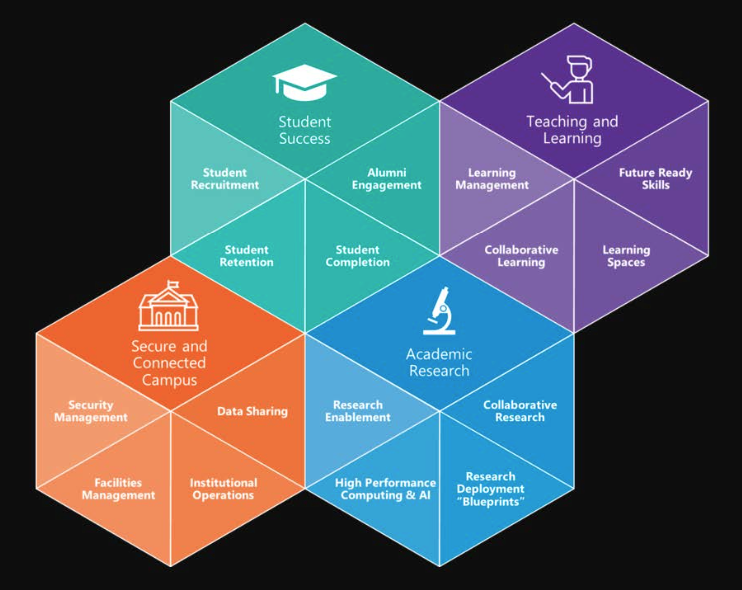
AI in Action Today
AI-automated features like chatbots and dynamic messaging are obviously already playing a huge part in converting prospective students and retaining their loyalty throughout the university-customer lifecycle. For instance, chatbots at many universities are now delivering relevant and helpful stakeholder messages. In addition to helping students find information quickly and accurately, these chatbots also helped reduce “summer melt” (where students are removed from enrollment due to non-response on necessary documentation).
Similarly, machine learning is creating new opportunities by uncovering patterns and improving processes. In one case, the Politecnico di Milano in Italy uses a Microsoft Azure AI-powered platform to assess students’ professional skills, and then provides them with personalized content to help fill in the gaps between their career goals and their present state.
Integrating AI: No Coding Required
One huge benefit of machine learning systems is that they do not require users to build their own models; for instance, Microsoft allows users to use pre-built models in user applications. This eliminates half the time and costs of traditional methods. The key then becomes leveraging the tools to mirror the behavioral patterns of inbound marketing funnels, progressive messaging, and segmentation content development—the domain of neuromarketing practices over the last decade.
From a future perspective, point systems, which are not capable of integrating with next-gen technology stacks, become a drag on efficiency. Remember that these smart tech stacks require universal data formatting, which is not possible in individual (siloed) point systems.
Another opportunity unlocked by enterprise systems’ use of AI is counterintuitive: machine learning empowers communications to be more personal and humanized. There exists a misconception that AI and machine learning are at odds with creativity. In fact, the opposite is true, and human capabilities unlocked by data lead to new possibilities. When creativity is informed by data, it is significantly more impactful.
Learn About the Progress and Ease Implementing Artificial Intelligence

Is Slate the “Best” Solution?
After studying the software architecture and the most likely purposing and uses, it is the authors’ opinion that Slate will dramatically increase the hours it takes to achieve data use and security on behalf of the students.
If the ultimate goal is assuring the digital brand experience, there are real design architecture barriers in the software and its intended uses that will silo the data through method, process, or practice. Therefore, by the nature of the silo within a university setting, any enhancement or change will be perceived as too difficult. Alternative workflows will not be possible and nominal functionality gains will be perceived as enough or even too tough.
This will not be the reason for the dismissal, though. In fact, the single dimension ROI and small step toward what is possible might be attractive to risk adverse and slow-to-change industry areas. As the organization is happy with the newfound capability, the biggest challenges include:
The Software Trap
New software built on old stacks traps organizations into what is already a decade behind the current possibilities and an entire generation of software away from the next generation of software. As the organization invests the next decade accumulating infrastructure and data processes, they are actually creating a massive, damaging technology debt. More is sequestered for longer periods of time from all other operational areas responsible for the student experience across the organization.
In some university cultures, this is a commitment to keep the university, or some departments thereof, away from the capabilities of machine learning and capabilities and the ability to adopt fast, inexpensive AI innovations coming over the next five years.
The data is kept away from secure reservoirs that allow it to be safely and efficiently leveraged in previously unimagined ways. The motivations behind selection should not be department-specific; left on their own, departments will gravitate toward a software that aligns with their individual priorities. Departmental leaders may choose application software where they don’t have to work through IT, or the areas of marketing, advertising, student services, operations, staffing, HR, learning, etc.
Key Challenges with Point or Partial Solutions
| ISSUE | SOMETHING TO CONSIDER |
|---|---|
| Admissions only solution | “Recruit to retain.” Admissions flows directly into students’ experiences, consisting of many university touchpoints that last a lifetime. |
| Departmental solution | A university-wide solution means knowledge about the applicant is seamlessly used for future guidance. |
| Silos rely on data movement, which relies on intervention to determine what information is passed to other systems | Data can be used back and forth to inform machine learning algorithms for enrollment and retention scoring. There are no missed connections because we are not working in silos by department. |
| IT and other discipline experts, such as marketing, alumni, and student services, are often left out by means of single consideration configuring and data sharing practices | IT managers often lament the fact that admissions decided to purchase, specify, or configure systems on their own. A university should be all in when it comes to the institution owning the data and ensuring it’s complete and in sync with IT data governance. |
| Proprietary platform | Best of class platforms, such as Azure, means standards are set according to the largest and one of the most advanced technology companies in the world. All we need to do is focus on higher ed code and configurations. Azure platform gives us a common data model (CDM), integration, and PowerApps, such as Power BI and Power Automate—straight out of the box. |
Some Archive Issues to Consider
- Emphasis on full student lifecycle
- Work across all administrative offices; not just admissions
- Azure Cloud and all the baked in solutions (Power BI, integration, common data, etc.)
- Product roadmap and strategy
- Robust and in lock step with MSFT build out of dynamic CRM

Slate Published Info
Designed and developed exclusively for higher education, Slate is the only solution that can handle the breadth and depth of modern admissions and advancement. Encompassing CRM, outreach, travel management, online applications, and online reading, Slate is trusted by more than 1,000 colleges and universities.
Slate.org is a free tool for school counselors, independent counselors, and community-based organizations to ease the burden of scheduling visits with college representatives, maintain awareness of where students reside in the admissions process, and conveniently and securely submit materials directly to institutions.
Slate.org is designed to provide a stronger relationship between school counselors and admissions offices by keeping everyone on the same page with your students’ best interests at heart. We’re here to provide a conduit for sharing data, not to sell it. Student data will never be bought or sold, and Slate. org is free, and will remain free, for everyone including students, schools, counselors, and colleges.
Founded in 1994, Technolutions introduced Slate, its flagship information management system at Yale University in 2000. Technolutions has served the education industry for two decades. Since the genesis and incubation of Slate, Technolutions has advanced exponentially, becoming the de facto standard-bearer for admissions technology.
All above information can be found on slate.org.

Slate Comprehensive Overview
Claims
- Pricing: all inclusive; claims low TCO; no surprises; can always get out of it.
- Claim no integrations with third party tools.
Technology Assessment
- Closed box for admissions office only.
- Host their own servers, not disclosed where.
Partnerships
- None found other than what is directly related (like imports or payment vendors). Claims they don’t need them.
Market Positioning
- Everything built in-house.
- No outside funding.
- One low TCO—no extra fees for anything, no contract lock in.
Target Market
- Small schools, little technical support, never had a CRM, struggle with basic capabilities, lots of manual processes (non-digital), are in an elite peer group (ivies, sisters, etc.) and don’t need efficiency or functionality to compete.

Features
- Online app
— Institution branded .edu
— Upload files including multimedia
— Application status check on same page
— Video interviewing - Online reading
— File bins, workflows
— Annotate, rate, send to colleagues
— iPad version
— Program managers complete the setup - High-definition digital portfolios (already listed above; can upload multi-media files up to 5GB).
Events and Travel Management
- Trips and events (organize events into ‘trips’), includes driving directions.
- Printable itineraries, postcard announcements, name badges, and flyers.
- Send electronic invites (e-vites) to prospects in the area, and organize automatic campaigns on an office-wide basis.
Design forms and registration pages and schedule confirmation, reminder, and thank you emails for the event while keeping track of your registrants in real-time. The drag-and-drop form builder enables rapid provisioning of custom web forms.
Email Campaigns
Slate’s Deliver tool makes it easy to send personalized emails to large groups of people. Use the query builder to pull a custom list of prospects or applicants, or upload your own list from any Excel spreadsheet. Apply templates, embed images, and customize your emails through the web-based HTML editor. Track the success of each mailing with automatic bounce back and opt-out management, open- and click-tracking, and integration with the student interactions record.
Document management is built into Slate.
Constituency Portals
Interactive portals can be rapidly provisioned and hosted using self-service technologies and APIs built into Slate. Choose from a library of ready-made portals, including portals for alumni volunteers and alumni interviewing programs, athletic coaches, and college counselors. Portals enable these constituency groups to have controlled access to sensitive data and programs.
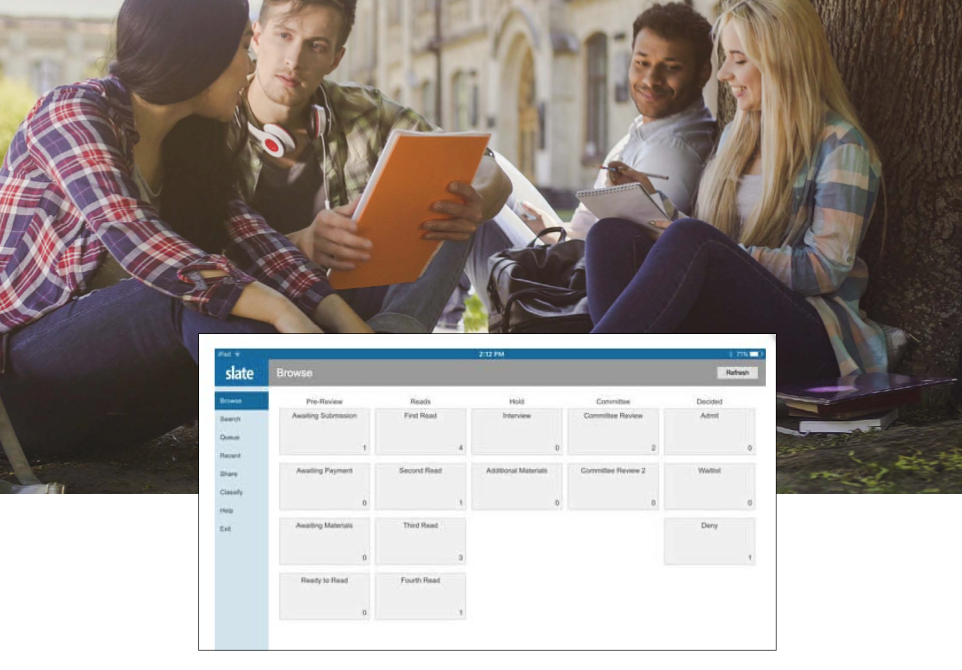
Slate Product Features/Presentation
Notes from viewing the Slate demonstration video;
- Admitted student portals have connections to social networks.
- Mobile design for online application and responding to admissions offers.
- No outside investors.
- Built on SQL and Javascript.
- Forms are internationally optimized (municipalities, regions, territories).
- Includes map integration, for example, events with search by radius.
- Embeddable event widgets, xml, feeds, etc.
- Unclear how multiple applications per contact work—appears to only handle one at a time on its own tab.
- Upload file outside of Slate to use for an email communication (versus uploading in app).
- Send attachments in email broadcasts.
- Highlight calendar connection—iCal feed of counselor’s events can link up to their own calendar.
Implementation Considerations for this Style of Software Adoption
Layered implementation is recommended from the company.
- Training takes precedent—it impacts everything else.
- One-week immersion bootcamp is offered.
- Initial focus is on back-end data discovery/imports, then configuration.
- The middle includes building out the online application and branding.
- Online application launches between months six and nine, but for a future start.
- After that, ancillary activities are built out (i.e., campus visit schedule).
- Implementation timeline of nine months to one year is recommended for this planned activity.
Timeline (12 months)
- Project Management is not overt. Focus is on individual assignments and weekly deliverables/milestones.
- Established protocol for escalation—on each weekly call, if there is an issue, they immediately schedule a call to align resources to understand and resolve the issue.
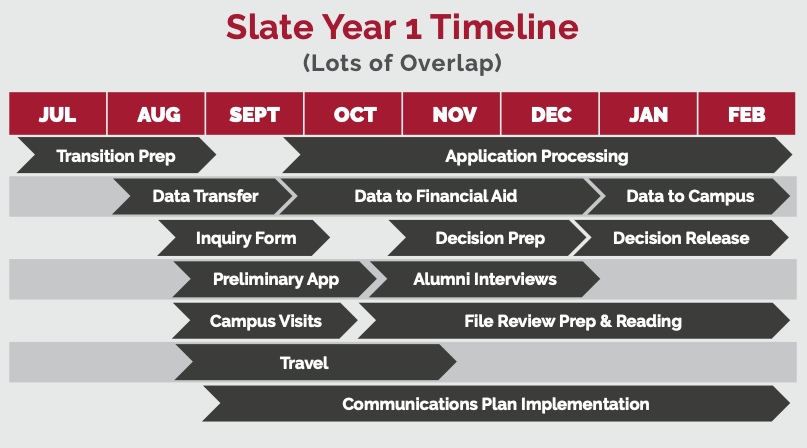
Functional and Technical Resources
- IT participates in meetings to stay aware.
- IT’s heaviest lifting is on day one to fill out technical information (domain name, servers, etc.).
Data Migration
- Must be completed in a certain way.
Location
- Two onsite events
— One-week onboarding bootcamp (three to four people from Admissions attend, no one from IT attends), no charge beyond room and board.
— User conference (100 percent representation from every customer), customer- driven presentations, new functionality overview, etc. This is inexpensive at $300-$400 per person.
Other Points of Interest to Consider
- Appears that the owner has no motive to sell the company. He’s passionate about the mission and has been doing this for 20 years.
- Ongoing support is questionable—word on the street is that Slate isn’t responsive to customers.
- Slate positions itself as admissions experts; they have no desire to go across the enterprise, they are notably “not a software company.” Leadership has been asked if they are going to expand into the rest of the SIS world. The CEO responded no, recruiting and application submission is their expertise. They don’t consider themselves themselves a software company.
- Reference this deployment from an inside perspective with insights after deployment:
Competitive Intelligence and Technical Feedback
Below includes a summary of competitive intelligence and firsthand technical use feedback from active developers in Slate, conducted by technical press via phone call, with active and existing customers and technical support staff. Two universities were interviewed.
University One—Technical Perspective
History of admissions CRM:
- Connect
- Radius
- Slate
Question: Tell me about your hands-on experience with Slate.
- Developer who was working on the implementation left—Slate implementation was left in a weird place; support was bad.
- Can’t get Power BI to connect to Slate—needs to be done on its own. All flat file based.
- They say “you don’t need IT.” That’s ridiculous. Report interface vs. query considered ‘ass backwards,’ he’s watched the YouTube video and still can’t do it. Query building is easy, but the average user can’t build it.
Question: How do you report numbers out of Slate through SIS?
- Radius, cams, and Slate. You have to integrate it yourself.
- Slate is a sophisticated TOOL KIT. You (customer) have to build a great deal of the product to fit your needs—from fields, reports, queries, etc.
Question: What about support and implementation?
- Virtually nonexistent.
- No standard reports—use query builder.
- Need to have someone on staff that understands data structure to take advantage of the power.
- All built using SQL—requires someone with strong IT technical background to really make it work.
- Many end users love it, compared to what they had, but they don’t understand what it takes to set up and make it run.
- Need to build implementation from scratch…add fields, etc.
Question: What about support turnarounds and troubleshooting?
- Tickets take a long time to be addressed.
Releases:
- No release schedules.
- No roadmap—clients spent time building out features without knowing what is coming
- Announcements are given at user conferences.
Question: What about integration nuances?
You take the information and do a straight dump; no chance to clean it up until afterward (the client had to clean it up). Advice to new customers: stop them from dumping until you talk to them. They provide an integration tool to import/export built on .net.
- Closed system; no room for extensibility; no out of the box integration to the rest of the campus ecosystems.
- Any configuration beyond the basic implementation requires uniquely trained technical staff (as opposed to the ease of finding SF, MS, or HS admins around the country).
- Hosting their own product; can’t compare to MS or SF data centers.
- Online events registration first. Common app was ‘easy’ because they handle all integrations. They have a download tool that Slate uses from behind the scenes. Jobs are set up to grab SDS files every night. Suspects, prospects, and applications.
- Set up the reader; no paper files.
University Two—Marketing Perspective
The following section contains notes and and observations from a marketing department leader for an Ivy League school who uses Slate in admissions. In order to achieve marketing-centric functionality, the marketing department was required to move to SF for their needs.
Question: From one marketing leader to another, what was it really like to work with Slate for marketing purposes?
- Reports are very hard to tailor.
— Form builder is not flexible. ex: a university only wanted to ask for state (not full address) on the inquiry form. Slate could not do this. So, the university created their own form, which saves data to Excel and uploads to Slate every night.
— Can’t track multiple active inquiries (only one can be active).
— Can’t get Slate on the phone for support (again, something we keep hearing). It’s all hands during the sale, then they disappear.
Note: Slate did a scheduled call one time per week with one person in their office; no ability to pick up the phone and call in.
On a positive side, it is a solid product from a very capable team that eats and sleeps higher ed admissions. It is feature-rich, and constantly improved with an engaged and active user community. That’s the positive.
The negative is the company. They are capable, but they are also myopically cocky. They iterate and improve their product, but they have no problem breaking your existing processes and then leaving you to patch things up while they “refer the issue to the custom development group” with no ETA ever. They do eat and sleep admissions, but they are mostly geared toward undergrad. Grad school admissions differ just enough for us to have to constantly ask for something new— some of those requests are granted, some are denied and there is no recourse.
The product is easy to use and modify, but it doesn’t mean that you don’t need dedicated technical staff to maintain it, not only cycle over cycle, but even within a single admissions cycle. And prepare for your technical staff to poke around in the dark trying to figure out how to do stuff as the documentation is minimal to non-existent and again, response from staff is spotty.

Question: What about integrations?
- Integration with Salesforce, HubSpot, or Dynamics is possible as the data within Slate is normalized and many export/imports options are available. That being said, the tool itself is marketed as marketing self-sufficient, in that it comes with email marketing component and event management component to where many admissions admins will only see the need to then dump out enrolled students into other applications. And this is the problem. We pivot from idea to publishing on the street in 10 days. Admissions cant set a meeting to talk about something for the first time in 10 days.
Anytime you want to do something to leverage the data for marketing, it becomes a cost prohibitive chore with university silos.
And even when you get to it, they have dubbed it down to only their purposes and terminated the value we in marketing could generate from those interactions. But they do get the meeting scheduled easier in admissions. And do you really want admissions with their autocratic tone wagging their fingers at the prospects for deadlines. It digresses very quickly to the tone of 3rd grade teachers scolding wayward children and with fierce automation. For every app they get, they will turn off 10 from the brand.
This sentiment will persist among admissions departments to keep all control within their departments. If this is empowered by providing a silo to do these things, it then will severely limit marketing and student services and alumni functions from progressing and force more one-off solutions due to the silos.
- To give you an idea, our VP of admissions said, “Hard to imagine a use case that would dictate not utilizing one of the built-in tools in favor of any other solution.” That is the case in point. If you give admissions Slate, then they will use it only for their purpose and you an kiss goodbye your constituency data. You will be lucky to get the student’s enrolling address and a student photo they took.
Consultant Marketing Perspective
The following section contains feedback from marketing consultants about the Slate product. The full review can be found here.
Question: What do you like best?
- Slate is very user-friendly…. You can do anything from managing text messages sent to students to reviewing applications to answering and tracking emails.
Question: What do you dislike?
- The technology is still slightly new, so there are some improvements that need to be made. But, luckily, as an admissions counselor, I don’t have to deal with them!
It’s mostly the background data management that struggles with doing certain things.
More Competitors’ Thoughts on Slate:
Who is right for Slate? Small schools (or departments) with little technical support, who never had a CRM and struggle with basic capabilities, lots of manual processes (non-digital), are in an elite peer group (ivies, sisters, etc.) and don’t require capability or efficiency to compete.
Consider that many colleges among the elite are used to outdated processes and systems. They haven’t needed innovation and new efficiencies to compete for market share and brand awareness. Unfortunately, smaller, change-averse universities look to these elite schools as “social proof,” and solution suppliers work hard to take advantage of this. They position products to take advantage of the idea that a software’s quality is gauged by who in the Ivy League may have incorporated it. The challenge is these are precisely the universities that need capability and efficiencies most.

Buzzword Soup
Admissions systems go by many names, as varied as the functions they perform and the business process requirements they fulfill. Brochures and demos only tell part of the story. There are several key factors to consider when evaluating an investment in a relationship with a technology vendor.
Many systems are available to admissions today—from legacy systems provided by companies that have been around for decades to newer companies just coming on the scene. There are many factors to consider when evaluating an investment in a relationship with a technology vendor—the platform matters.
In the past, admissions systems were proprietary, owned by companies with little revenue and no financial backing to maintain their viability. Colleges trusted their important admissions data with these companies to not only provide tools to recruit students, but also to keep the data secure. Many times, it was stored on campus—one of the least secure locations at that time. Next came cloud storage.
Then came powerful, innovative companies who built infrastructures to provide robust capabilities and world-class security supported by hundreds of millions of dollars in funding. These systems are based on a modern platform and can take advantage of significant in-platform R&D investments which secure its position as the most innovative foundation to build upon. These innovations allow users to focus on the industry-specific capabilities—not the core heaving lifting functionality.
If the school is looking for just a point solution with no idea of business process reengineering or review, and does not care about normalizing and leveraging user data across the enterprise now or in the future, Slate is, in the authors’ opinion, one of the better band-aids of choice.

Turning Insights into Action
Avoiding another point solution will allow a university to go beyond historical methods of student support and brand ideals. It will seamlessly empower the university and all its internal stakeholders to aggregate data access to student touchpoints, and actively shape the digital student experience through them.
Turning insights into action is the key. Point solutions separate data and functions, and slow the ability to capitalize on new opportunities. As we move forward, education should focus on connecting in real time with students, which is needed to support the student’s journey and experiences with the brand. However, we must remember that each student (customer) has a different path to success, and it must be loaded digitally.
With this in mind, the future for universities requires a single, unified platform to innovate and create custom applications with the support of enterprise-grade tech stacks such as Oracle or MS Power platforms. These allow efficient accessibility to support the next-generation solution sets as a university competes within education and industry.
One such platform is Microsoft Power BI. It requires only a minimal investment, so long as the organization isn’t tied up with point solutions that silo their data. Additionally, student data needs to reflect the unique attributes that represent the uniqueness of each student or learner. This requires adding many more insights into student records, which is not practical for individual department data silos.
University Opportunities and Challenges in Implementing Enterprise Tech Stacks
One opportunity facing next-generation intelligence platforms includes having the ability to identify at-risk students, and target them with early intervention to support their learning and brand experience. This will become key in the next 10 years and will require not sequestering student records in admissions, where it becomes too cumbersome for a university to leverage the data or available technology.
It’s inspiring to note that diverse organizations around the world have already leveraged this information to accomplish their missions more efficiently. The AI for Good program by Microsoft has benefitted organizations working on a number of issues, including climate issues, sustainability, medicine, accessibility, and more.
Major platforms have challenges as well. They include frequent upgrades with high digital change and convergence. Software built on the top-level new technology stacks have shown their value proposition to the education industry. One example is the billion dollars of R&D released within the Microsoft Azure stack addressing higher education ecosystems with the same functionality leveraged in all other industry sectors. Now, universities have the opportunity to build upon the modern enterprise software stacks—they can upgrade and usher in the age of AI, with a shift of migration work, for the price of a nominal investment. In stride.

Recommendations
As mid-sized brands competing nationally, we recommend universities build enterprise-level systems that can take advantage of the enterprise tech stacks of the future, side by side with the market as it changes and brings with it all the security as well as past and future compatibility.
This will enable a university to leverage billions of developments by others and keep up with changing competitive, environmental, and customer expectations. It also allows them to prepare for, and keep up with, the progress of AI and machine learning in business and customer interactions. Additionally, as all these two-way IoT communications and live interactions compound, the necessary security cannot be matched by any of the independent players, particularly for a yearly contract with an application software.
Upgrade existing enterprise systems. Get new functionality and bring university data with you. Stop the patchwork of buying the latest feature patches or “point solution” to achieve new functionality. Or, buy a new enterprise system and optimally configure it to start with.
The concept: instead of spending $2.00 in 10 areas of functionality, invest $12.00 once for a secure, upgraded system that can handle the end-to-end student journey with the brand.
If the university wants to continue to fragment its tech stack capability, for perceived easier short-term gains, the siloed departments should allow subject-specific professionals to configure the individual subject-specific functionality of the software to get the most out of it and minimize the downsides of continuing the technology debt.
Deploy 360-degree “student at the center of the brand” thinking.
This thinking should encompass the students’ overall brand experience in the configuration methods, data mapping, storage, and naming methods that go beyond known uses. Deploy new training practices to achieve enterprise-wide common data use functionality.
Allow each part of the upgraded enterprise system to be natively configured around each department’s unique use. This is determined by the discipline- specific professionals that understand what else can be added to a university’s tribal knowledge and job capability. This stands in contrast to silo deployments by generalists, configuring it to known past benchmarks after limited training, and allowing each department to ask for more functionality through work orders or additional budget years. Make it scream for the users from day one or do not deploy it.
Additional AI and Machine Learning Information
FabCom is a full-service strategic marketing, PR, and advertising firm
Principal: Brian Fabiano Employees: 38
Local Area Billings: $42.1 Million*
Location:
7033 E. Greenway Pkwy., Ste. 350
Scottsdale, AZ 85254-8120
Contact:
phone (480) 478-8500
fax (480) 478-8510
fabcomlive.com
*Amortized for media billings as calculated in the Phoenix Business Journal Book of Lists.
NOTE: The creators of this perspective are technology and software agnostic. FabCom is a top strategic consulting and professional services Marcom agency that specializes in integrated marketing and advertising that creates amazing brand experiences. These opinions are based on the perspective of 100,000 hours of expertise as a firm implementing university systems since the dawn of online education. The agency charges labor hours to provide content or functionality within any system. This marketing white paper is based on the research and deep experience across all segments within the education industry. This document represents an analysis of university targeted point solutions in comparison to enterprise solutions. Available knowledge was considered at the time of publishing. This is not an endorsement by these companies or intended to imply association or malicious intent toward the companies or software mentioned. The wordmarks are solely owned by the individual companies and have no affiliation or licenses with FabCom. If any information is incorrect, please email FabCom at [email protected] and we will be happy to address updating the white paper.
